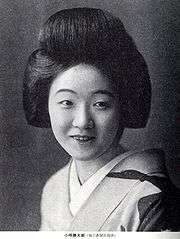Katsutaro Kouta
| Katsutaro Kouta | |
|---|---|
 | |
| Background information | |
| Birth name | Katsu Shinno |
| Born |
November 6, 1904 Nigata prefecture, Japan |
| Died | June 21, 1974 (aged 69) |
| Genres | Ryūkōka, Min'yō, Hauta, Kouta, Kiyomoto |
| Occupation(s) | Singer |
| Years active | 1930–1974 |
| Labels | Victor, Columbia, Teichiku, Toshiba |
Katsutaro Kouta (小唄 勝太郎 Kouta Katsutarō, November 6, 1904 – June 21, 1974) was a Japanese female geisha and ryūkōka singer. The genre like her songs was called "New-Minyo".[1] The era when she had a high popularity with another popular geisha singer Ichimaru was called the "Katsu-Ichi Era".[2]
Career
Katsutaro accepted as a geisha at Yoshicho hanamachi(geisha district) around 1925. Around 1928 a geisha from the same hanamachi, named Fumikichi(二三吉) had several hits in Victor of Japan. In 1930 Katsutaro recorded some hauta and kouta song with Odeon Record and Parlophone. A year later she signed exclusive contract with Victor. She debuted with the song "Sado Okesa" (佐渡おけさ) in 1931. She released song "Shima no Musume" (島の娘 lit. Island Girl) in 1932. The song became a big hit in 1933, selling 600,000 copies.[3] However, the song also angered members of the Home Ministry because the song described illicit sexual relations.[4]
In 1933, Katsutaro and Issei Mishima released duet song "Tokyo Ondo" in June or July when Bon Festival in 1933. The song composed by Shinpei Nakayama. It sold 1.2 million copies and became the highest selling single in Japan at that time.[5] Also in 1933, she leave the geisha world to concentrating on her new profession as a recording artist and dropped the Yoshicho name, became just "Katsutarō".
Then in 1934 spring season, she, Mishima Issei and Tamaki Tokuyama release the song Sakura Ondo and also became a big hit. On the same year, she received name "Kouta Katsutarō" in an open exhibition. After the name change, she released more song and even became bigger star. Even songwriter Nagata Mikihiko(長田幹彦)dubbed she and Ichimaru as "Emotional Katsutarō and Intelectual Ichimaru". And around mid 1930s is called the "Katsu-Ichi Jidai" (勝市時代 Katsu Ichi Era). In late 1930s she and other singers called to China to performing for Japanese troops in China. And when she sick there, she met military physician Shinno Ryouichi, the two became a couple and married in 1949. In wartime, she recorded the song Asu wa Otachika and became a hit.
After war ended she transferred to Columbia and in 1948 to Teichiku, and her song Oshima Jowa became a hit and used for a film with the same name. In 1950 she with Watanabe Hamako invited to America for perform, with addition to Brazil with Taro Shoji where she get a warm welcome from Japan citizens there.
She took part in the Kohaku Uta Gassen three times. In 1961 she transferred to Toshiba Record where she recording most hauta and kouta song. Around mid 1960s she back to Victor to re-record her hits in Victor. In 1971 she get award Shiju Hosō and an award again in 1974. In June 1974 she diagnosed from lung cancer and die on June 21, 1974 on Fuchu Hospital at Tokyo when aged 69. On September 25, 2005, a monument to Kouta was established in her birthplace, Niigata.[6]
Discography
- Shima no Musume (島の娘 Island Girl) : 1932
- Tokyo Ondo (東京音頭) : 1933
Sakura Ondo : 1934 Gion Bayashi : 1934
- Manshu Gurashi (満州ぐらし Life in Manchu) : 1936
- Kenkoku Sakura (建国さくら National Foundation Sakura) : 1940
Oshima Jowa(大島情話) : 1948
References
- ↑ "Yokohama's New-Minyo" (in Japanese). Yokohama Archives of History. 2008-07-30. Retrieved 2009-01-21.
- ↑ "The day that singer Ichimaru died" (in Japanese). Nippon Television. 2009-02-17. Retrieved 2009-03-02.
- ↑ 新潟市議会請願第2号文書表 (in Japanese). Niigata City. 2003. Archived from the original on 2012-09-05. Retrieved 2009-01-21.
- ↑ ビクターの新鋭作曲家・佐々木俊一 (in Japanese). JANJAN. 2006-05-04. Retrieved 2009-01-21.
- ↑ 踊り踊って東京音頭 昭和8年 (in Japanese). NHK. Retrieved 2009-01-21.
- ↑ "Katsutaro Kouta" (in Japanese). Niigata City. 2005-10-02. Retrieved 2009-01-21.